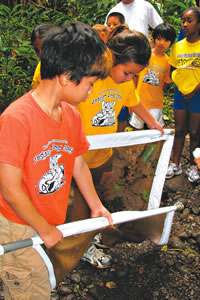Ecosystems In Good Hands

By .(JavaScript must be enabled to view this email address)
E-mail this story | Print this page | Comments (0) | Archive | RSS | Share
 Del.icio.us
Del.icio.us
|
The Lelekamanu Program, an educational outreach of Papahana Kuaola, received an outpouring of support from 110 East Oahu third-graders this past year.
The Aina Haina Elementary students, four teachers and one Hawaiian studies teacher from the school visited two native Hawaiian ecosystems to record and collect data for the program’s Malama i na Kahawai project.
“The students had to learn about the Hawaiian streams - from their formation and connection to our water cycle, to the native, introduced and invasive plants and animals,” said lead teacher Shawn Nakamura, noting that they drew connections between the mauka and makai ahupua’a systems and their importance to early Hawaiians.
Led by Jessica Tafao, they visited Heeia’s stream and fishpond in Windward Oahu. They tested Heeia Stream waters for flow rate, turbidity, salinity, temperature and depth, and returned later to focus on the plant and animal life. At the ancient He’eia Fishpond, complete with walls and gate, Nakamura said it “showed them the stream as a connection or connector between the mountain and the ocean.”
After each trip, they made notations in a journal provided by Papahana Kuaola and on the Web site lelekamanu.com. To thank the young researchers, the nonprofit agency presented to them copies of a book of their writings and artwork at a May assembly at the school.
“The students were so amazed to see their responses published in the book,” Nakamura said. “I think it gave them confirmation about the value of their responses, that their responses counted and someone thought it was good enough to publish.”
Supported by a B-WET Hawaii grant from NOAA, Malama i na Kahawai’s goal is to teach students and teachers to understand, respect and care for unique native Hawaii ecosystems specifically related to streams and to be responsible stewards.
As they see changes people make to the land and ocean, Nakamura said the children have profound observations, such as “Channelization is good for you and me, but not for the plants and animals.”
“These days, children don’t get to explore and play in streams very often,” she added. “There is so much to learn about this Hawaiian ecosystem. Anytime you can take the classroom out into the real word, that is fun!”
E-mail this story | Print this page | Comments (0) | Archive | RSS
Most Recent Comment(s):













